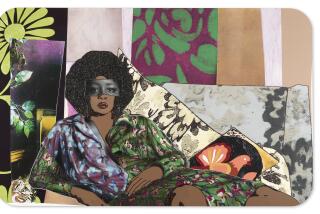Insights of ‘Blind’ in Eye of the Beholder : Art: Sophie Calle lets those without sight speak of beauty and lets the resulting exhibition speak for itself.
With a little prodding, French contemporary artist Sophie Calle will discuss the mechanics of her compelling installation “The Blind.” She says next to nothing, however, about its meaning, preferring to let observers draw their own conclusions.
“I don’t like to comment on my own work,” Calle said recently, adding that she’s averse to being quoted.
“I never find in the [printed] interview what actually went on, my words. At the same time, I don’t don’t want to control anybody’s article. Just write whatever you feel like. It’s your article.”
Before creating “The Blind” in 1986, on view at Newport Harbor Art Museum through Dec. 31, Calle asked two dozen people who were born blind to describe their images of beauty. The installation consists of a photo of each man or woman, girl or boy, together with a quote summarizing his or her image of beauty and a photograph of that object, person or place.
A boy, whose portrait hangs beside the photo of a patch of grass, told Calle: “Green is beautiful. Every time I like something, I’m told it’s green. Grass is green, trees, leaves, nature too. . . . “
One man whose portrait hangs above the picture of a woman with long tresses told Calle: “Hair is magnificent. Especially African hair. I curl up in women’s long hair. I pretend I’m a cat and meow.”
Another, his picture next to his son’s portrait, told the artist: “I saw my son in a dream. He was 10 years old. He was in pyjamas [sic]. He looked at me and smiled. He walked towards me. I thought he was very beautiful.”
Was Calle bent on exploring the definition of beauty? Or did she intend, above all, to raise questions about the gap between perception and reality, between appearance and truth? How close, after all, can a born-blind person’s image of beauty be to those of sighted people? And doesn’t something get lost or altered in her translation of those images?
In a recent phone interview from her home in Paris, Calle, 46, politely eluded those queries. Perhaps that’s no surprise from an artist whose sensibility concerns the gray area between fact and fiction.
To produce “The Hotel” (1981), a well-known piece typical of her invasive style, Calle worked as a hotel maid for three weeks. Like a spy, she photographed hotel guests’ unmade beds and messy rooms, then used the photos and text she wrote about her searches to create a portrait of people she never knew.
In “L’Homme Au Carnet” (“The Man With the Address Book”) (1993), she created a written portrait of a man--again, whom she never met--by interviewing his friends. She found their names in the man’s purportedly lost address book.
Given this track record, said Newport museum chief curator Bruce Guenther, “it’s entirely conceivable that absolutely nothing about [‘The Blind’] is true.” None of the blind people are named, Guenther noted. Are we to believe that these are in fact their quotes? Or could it be that Calle made up the statements?
It seems unlikely. Calle may orchestrate situations and make sly suggestions. She inferred, for instance, that romance took place in the rooms she cleaned in “The Hotel.” Full disclosure and provable fact may not be her prime concern. But she documents what she sees.
*
Without a trace of deception in her voice, she said that the quotes in “The Blind” are legitimate. There was simply “no need” to include the blind people’s names, she said, adding as “in all the things I do, you just have to trust me.”
Explaining other mechanical elements of the exhibit, Calle said she did not shoot every photograph on view.
“For example, a woman spoke of a countryside in Cardiff” as beautiful, she said, “and the woman took the photograph herself. She pointed the camera in the direction of where she thought the beauty was and took the photograph herself. The man who said the most beautiful thing he had seen was his son took the picture of his son himself.”
One girl said French actor Alain Delon typified beauty, but Calle bought Delon’s photograph, rather than taking it herself, because “it was not my vision of Alain Delon that was necessary,” Calle said.
Although producing “The Blind” taught her as much as any “experience or situation you are in,” Calle said she didn’t set out to learn about being blind.
“It was not part of the project,” she said. “It was not a sociological project.” Only after completing the work did she think about why she wanted to photograph blind people to begin with, she added.
Since the untrained artist’s first effort in 1979, in which she followed pedestrians around Paris and photographed them, Calle has remained anonymous to many of her subjects.
Perhaps working with the blind, she said, was a way to “see without being seen again, but without having to hide myself.”
* “Sophie Calle: The Blind” is on display at Newport Harbor Art Museum, 850 San Clemente Drive, Newport Beach. Hours are Tuesday through Saturday, 10 a.m. to 5 p.m.; Fridays until 7 p.m.; Sunday, noon to 5 p.m. $2 to $4. Through Dec. 31. (714) 759-1122.
More to Read
The biggest entertainment stories
Get our big stories about Hollywood, film, television, music, arts, culture and more right in your inbox as soon as they publish.
You may occasionally receive promotional content from the Los Angeles Times.










